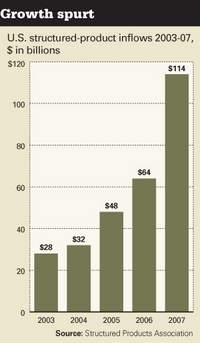by the Structured Products Association
How do structured products work?
A structured product can come in any one of several forms -- notes, units, shares, CD or trusts. Structured products typically provide exposure to an asset class with some additional feature that is desirable to an investor (and for which the investor is willing to pay a modest premium). These features include principal protection, moderate leverage, above-market yields, alternative investment exposure or tax advantaged returns.
If there's a "derivative" embedded in the investment, what are my risks?
All structured products have a derivative element , which provides the additional feature desired by the investor. Although many advisors generally have a negative reaction to an investment with an embedded "derivative," it should be noted that the derivative exposure often takes away risk from an investment (for example, principal protection). Indeed, many vanilla securities have "embedded derivatives" such as callable bonds and convertible securities. The most prominent risk of a derivative-added investment is a misunderstanding of how the ultimate payout formula on the structured product works.
What are the fees?
Predictably, the fees vary considerably, based on the term of the investment, the reference asset and the complexity of the structured product. A recent survey by the SPA demonstrated that most structured products charge between 25 to 50 basis points per annum, considerably lower than the 1.26% fees charged by mutual funds. This figure does not take into account the cost of distribution -- or the fee charged by the broker-dealer or investment advisor.
What are the investment minimums?
Many structured products are listed on exchanges, and on the initial offering can be as low as $10 per unit. A round lot of a structured investment (100 shares) would cost an investor $1,000 plus commissions. The trend over the last five years has been to reduce the minimums for the more vanilla structured investments for retail investors to smaller sizes, in part to reduce "concentration risk" and permit diversification of issuers.
Are the investments liquid or are investors locked in for long periods?
With over 60 issuers of structured investments, competition has compelled all firms to provide at least daily liquidity for their offerings. The top structured products distribution firms such as Advisors Asset Management and Incapital will not permit access to their platforms unless the issuers meet their high standards of liquidity-on-demand. Exchange-listed securities have 15 second pricing and instant liquidity. Investors are generally not locked in, however, because of the potential complexity of some structured investments, it is important to emphasize that these are buy-and-hold securities. The benefit of a particular structured product typically comes at maturity. Such is the case with a principal protected note where the protection is guaranteed only upon maturity.
Isn't this kind of like Las Vegas? When I lose, the house wins?
Contrary to the belief of even some of the more sophisticated brokers and advisors, structured investments are not a "zero-sum game" where the issuer wins only if the investor loses. The structured products industry is very keen to create products that will have superior risk-adjusted returns that outperform other investments; the growth of the market is highly attributable to the positive returns experienced by structured products investors. The majority of growth in the $120 billion-a-year structured products business comes from repeat investors.
If structured products are so great, why doesn't everyone have them in their portfolio?
Structured products have traditionally been available only to wealthy investors of private banks. After the dot-com market decline, many investors came to learn that structured products could repair portfolios, protect capital and enhance yield. Many of these investment strategies were then made available to retail investors beginning around 2003. Much like the ETF market, it takes awhile for a revolutionary idea to go mainstream. That said, MIT Professor Zvi Bodie sees the structured products market as a $1 trillion industry in the next several years, primarily because of its applicability to boomer wealth.
Don't I have credit risk with the firm issuing the product?
Generally speaking, yes. Much like any corporate bond, the return of the security is dependent upon the creditworthiness of the issuer. This time last year it was unthinkable that a structured products issuer with the global footprint of a Bear Stearns would experience a flash-bankruptcy over the course of a single week. (Of course, structured products had nothing to do with Bear Stearns' deteriorating balance sheet, which was actually occasioned by a toxic mix of leverage and subprime mortgage-linked investments.)
What happened to the holders of Bear Stearns structured products?
Happily, holders of Bear Stearns ETNs, structured products and corporate debt are better off now than they may have been previously. Ironically, the federal government now stands behind Bear Stearns credit, meaning its outstanding debt has the explicit backing of the US Treasury. But investors would be wise to not rely on Uncle Sam in case other financial firms falter. Many investors are purchasing structured product-linked CDs in amounts under $100,000 to take advantage of FDIC insurance.
Tuesday, September 9, 2008
Subscribe to:
Post Comments (Atom)



No comments:
Post a Comment